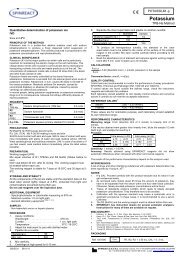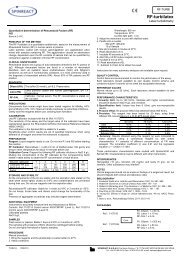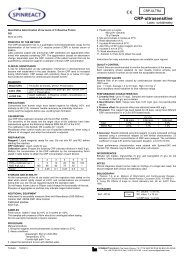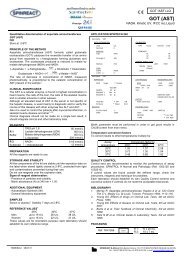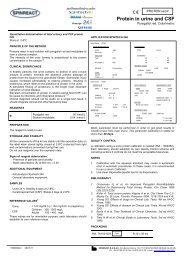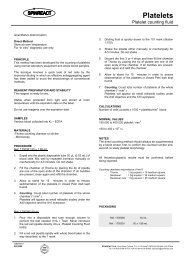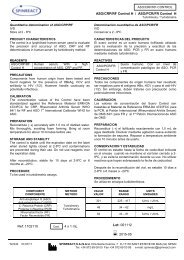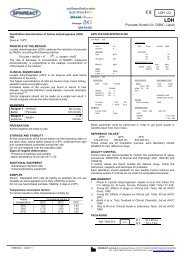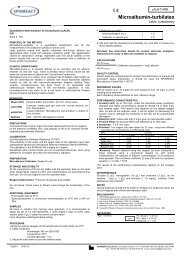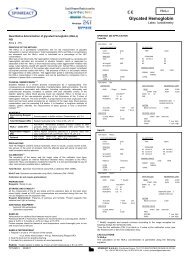Ceruloplasmin - Spinreact
Ceruloplasmin - Spinreact
Ceruloplasmin - Spinreact
Create successful ePaper yourself
Turn your PDF publications into a flip-book with our unique Google optimized e-Paper software.
Quantitative determination of <strong>Ceruloplasmin</strong><br />
IVD<br />
Store at 2-8ºC.<br />
INTENDED USE<br />
The <strong>Ceruloplasmin</strong> reagent is a quantitative turbidimetric test for the measurement<br />
of <strong>Ceruloplasmin</strong> in human serum or plasma.<br />
PRINCIPLE OF THE METHOD<br />
Anti-human <strong>Ceruloplasmin</strong> antibodies when mixed with samples containing<br />
<strong>Ceruloplasmin</strong>, form insoluble complexes. These complexes cause an absorbance<br />
change, dependent upon the <strong>Ceruloplasmin</strong> concentration of the patient sample,<br />
that can be quantified by comparison from a calibrator of known <strong>Ceruloplasmin</strong><br />
concentration.<br />
CLINICAL SIGNIFICANCE<br />
Caeruloplasmin is an α2-globulin that contains approximately 95% of total serum<br />
copper. Each molecule of caeruloplasmin contain six to eight copper atoms. The<br />
high content of copper ions gives caeruloplasmin a blue color. Caeruloplasmin can<br />
also bind, and possible transport, other cations such as magnesium. The molecule<br />
of caeruloplasmin has a single polypeptide chain and carbohydrate, and results a<br />
molecular mass of 132 kD. Caeruloplasmin is synthesized primarily by the hepatic<br />
cells and small quantities by macrophages and lymphocytes.<br />
Caeruloplasmin is most often quantified as a screening test for Wilson’s disease.<br />
However, it is important to realize that several other factors, including diet, hormone<br />
levels, and other genetic disorders, can influence plasma levels.<br />
Synthesis of caeruluplasmin is increased modestly in the acute-phase response,<br />
peaking at 4 to 20 days after a single, cute insult. Synthesis is also stimulated by<br />
estrogens, and during pregnancy.<br />
Low plasma caeruloplasmin levels are due to lack of incorporation of Cu 2+ into the<br />
molecule during synthesis. The causes are, the dietary insufficiency (including<br />
malabsorption), inability to release Cu 2+ from gastrointestinal epithelium into<br />
circulation, or inability to insert Cu 2+ into developing caeruloplasmin molecule.<br />
Levels may also be low in blood loss or gastrointestinal or renal proteinlosing<br />
syndromes.<br />
REAGENTS<br />
Diluent (R1)<br />
Antibody (R2)<br />
Tris buffer 20 mmol/L, PEG 8000, pH 8.3.<br />
Sodium azide 0.95 g/L.<br />
Goat serum, anti-human <strong>Ceruloplasmin</strong>, pH 7.5.<br />
Sodium azide 0.95 g/L.<br />
Optional Cod: 1102003 PROT CAL.<br />
CALIBRATION<br />
The assay is calibrated to the Reference Material CRM 470/RPPHS (Institute for<br />
Reference Materials and Measurements). It must be used the PROT CAL to<br />
calibrate the reagent. The calibrator should not be diluted, as it is ready to use. The<br />
reagent, monoreagent and bireagent, should be recalibrated every three weeks and<br />
every month, respectively. It should also be recalibrated when the controls are out<br />
of specifications, and when changing the reagent lot or the instrument settings. For<br />
monoreagent, a reagent blank should be run daily before sample analysis.<br />
STORAGE AND STABILITY<br />
All the components of the kit are stable until the expiration date on the label when<br />
stored tightly closed at 2-8ºC and contaminations are prevented during their use.<br />
Do not use reagents over the expiration date.<br />
Reagent deterioration: The presence of particles and turbidity. Do not use.<br />
Do not freeze; frozen Antibody or Diluent could change the funcitionality of<br />
the test.<br />
ADDITIONAL EQUIPMENT<br />
- Thermostatic bath at 37ºC.<br />
- Spectrophotometer or photometer thermostatable at 37ºC with a 340 nm filter (320<br />
– 360 nm).<br />
SAMPLES<br />
Fresh serum or plasma. EDTA or heparin should be used as anticoagulant. Stable<br />
7 days at 2-8ºC or 3 months at –20ºC.<br />
The samples with presence of fibrin should be centrifuged.<br />
Do not use highly hemolized or lipemic samples.<br />
PROCEDURE<br />
1. Bring the reagents and the photometer (cuvette holder) to 37ºC.<br />
2. Assay conditions:<br />
Wavelength : 340<br />
Temperature : 37 ºC<br />
Cuvette light path : 1cm<br />
3. Adjust the instrument to zero with distilled water.<br />
4. Pipette into a cuvette:<br />
Reagent R1 800 µL<br />
Sample or Calibrator 7 µL<br />
5. Mix and read the absorbance (A1) after the sample addition.<br />
6. Immediately, pipette into the cuvette:<br />
Reagent R2 200 µL<br />
<strong>Ceruloplasmin</strong><br />
Turbidimetry<br />
ITIS45-I 30/06/11 SPINREACT,S.A. /S.A.U. Ctra.Santa Coloma, 7 E-17176 SANT ESTEVE DE BAS (GI) SPAIN<br />
Tel. +34 972 69 08 00 Fax +34 972 69 00 99 e-mail: spinreact@spinreact.com<br />
CER<br />
7. Mix and read the absorbance (A2) of calibrators and sample exactly 2 minutes<br />
after the R2 addition.<br />
<strong>Spinreact</strong> has instruction sheets for several automatic analyzers. Instructions for<br />
many of them are available on request.<br />
CALCULATIONS<br />
(A2-A1)sample<br />
(A2-A1)calibrator<br />
x Calibrator concentration = mg/dL <strong>Ceruloplasmin</strong><br />
QUALITY CONTROL<br />
Control sera are recommended to monitor the performance of manual and<br />
automated assay procedures. <strong>Spinreact</strong> PROT CONTROL (Cod.:1102004).<br />
Each laboratory should establish its own Quality Control scheme and corrective<br />
actions if controls do not meet the acceptable tolerances.<br />
<strong>Spinreact</strong> has instructions sheets available for several automatic<br />
analyzers.<br />
REFERENCE VALUES<br />
Between 15 – 60 mg/dL. Each laboratory should establish its own reference<br />
range.<br />
PERFORMANCE CHARACTERISTICS<br />
1. Linearity limit: Up to 120 mg/dL, under the described assay conditions.<br />
Samples with higher concentrations, should be diluted 1/5 in NaCl 9 g/L<br />
and retested again. The linearity limit depends on the sample / reagent<br />
ratio. It will be higher by decreasing the sample volume, although the<br />
sensitivity of the test will be proportionally decreased.<br />
2. Detection Limit: Values less than 3.27 mg/dL give non-reproducible<br />
results.<br />
3. Precision: The reagent has been tested for 20 days, using three levels of<br />
serum in a EP5-based study (NCCLS).<br />
EP5 CV (%)<br />
28.96mg/dL 55.47 mg/dL 76.54 mg/dL<br />
Total 4% 2.3% 2%<br />
Within Run 2.2% 1.5% 1%<br />
Between Run 3.1% 1.1% 1.5%<br />
Between Day 1.1% 1.3% 0.8%<br />
4. Accuracy: Results obtained using this reagent (y) were compared to<br />
those obtained with a Bayer immunoturbidimetric method. 45 samples<br />
ranging from 20 to 80 mg/dL of <strong>Ceruloplasmin</strong> were assayed. The<br />
correlation coefficient (r) was 0.96 and the regression equation y =<br />
0.896x + 10.57.<br />
The results of the performance characteristics depend on the used<br />
analyzer.<br />
INTERFERENCES<br />
Hemoglobin (20 g/L), bilirrubin (40 mg/dL), lipemia (< 2.5 g/L), and<br />
rheumatoid factor (800 IU/mL) do not interfere. Other substances may<br />
interfere.<br />
BIBLIOGRAPHY<br />
1. Clinical Guide to Laboratory Tests, Edited by NW Tietz W B Saunders Co.,<br />
Phipladelphia, 483, 1983.<br />
2. Pesce AJ and Kaplan, LA. Methods in Clinical Chemistry. The CV Mosby<br />
Company, St. Louis MO, 1987.<br />
3. Dati F et al. Eur J Clin Chem Clin Biochem 1966; 14: 401-406.<br />
4. Young DS.Effects of disease on clinical laboratory tests, 3th ed. AACC Pres,<br />
1997<br />
5. Friedman and Young. Effects of disease on clinical laboratory tests, 3tn ed.<br />
AACC Pres, 1997.<br />
PACKAGING<br />
Ref.: 1102064<br />
Cont.<br />
R1. Diluent: 1 x 40 mL<br />
R2. Antibody: 1 x 10 mL
Determinación cuantitativa de <strong>Ceruloplasmin</strong>a<br />
IVD<br />
Conservar a 2 - 8ºC.<br />
USO PREVISTO<br />
El reactivo <strong>Ceruloplasmin</strong>a es un ensayo turbidimétrico para la cuantificación<br />
de <strong>Ceruloplasmin</strong>a en suero o plasma humano.<br />
PRINCIPIO DEL MÉTODO<br />
Los anticuerpos <strong>Ceruloplasmin</strong>a forman compuestos insolubles cuando se<br />
combinan con la <strong>Ceruloplasmin</strong>a de la muestra del paciente, ocasionando un<br />
cambio de absorbancia proporcional a la concentración de <strong>Ceruloplasmin</strong>a en<br />
la muestra, y que puede ser cuantificada por comparación con un calibrador<br />
de <strong>Ceruloplasmin</strong>a de concentración conocida.<br />
SIGNIFICADO CLÍNICO<br />
La <strong>Ceruloplasmin</strong>a es una α2-globulina que contiene aproximadamente el<br />
95% del total del cobre en suero. Cada molécula de <strong>Ceruloplasmin</strong>a contiene<br />
de 6 a 8 átomos de Cobre. El elevado contenido de iones Cobre confiere a la<br />
molécula el color azul que presenta. La <strong>Ceruloplasmin</strong>a también se puede<br />
unir, y probablemente transportar, otros cationes como el magnesio. La<br />
molécula de ceruloplasmina es una cadena simple polipeptídica con<br />
carbohidratos, y tiene un peso molecular de 132KD. <strong>Ceruloplasmin</strong>a es<br />
sintetizada principalmente por células hepáticas, y en pequeñas cantidades<br />
por macrófagos y linfocitos.<br />
El test de <strong>Ceruloplasmin</strong>a se utiliza muy frecuentemente como método de<br />
screening para la detección de la enfermedad de Wilson. Sin embargo, es<br />
importante tener en cuenta que muchos factores pueden influir en los niveles<br />
de plasma, incluída la dieta, los niveles de hormonas, y otros desórdenes<br />
genéticos.<br />
La síntesis de ceruloplasmina se ve ligeramente incrementada en la<br />
respuesta de fase aguda,.Su síntesis también se ve estimulada por la<br />
presencia de estrógenos, y durante el embarazo.<br />
Niveles bajos de <strong>Ceruloplasmin</strong>a en plasma se deben a la pérdida de la<br />
incorporación de Cu +2 durante la síntesis de la molécula. Las causas son la<br />
insuficiencia dietética (incluyendo malabsorción), dificultad para liberar Cu +2<br />
del epitelio gastrointestinal a la circulación, o dificultad para insertar Cu +2 en el<br />
desarrollo de la molécula de <strong>Ceruloplasmin</strong>a. Los niveles también serán<br />
bajos en síndromes gastrointestinales o que impliquen pérdida de sangre o<br />
pérdida de proteínas renales.<br />
REACTIVOS<br />
Diluyente (R1)<br />
Anticuerpo (R2)<br />
Tampón tris 20 mmol/L, g/L, PEG 8000, pH, 8,3.<br />
Azida sódica 0,95.<br />
Suero de cabra, anti-ceruloplasmina humana, pH<br />
7,5. Azida sódica 0,95 g/L.<br />
Opcional: Ref: 1102003 PROT CAL.<br />
CALIBRACIÓN<br />
El ensayo está calibrado frente a un Material de Referencia CRM 470/RPPHS<br />
(Institute for Reference Materials and Measurements, IRMM). Se recomienda<br />
el uso del Calibrador PROT CAL para la Calibración. El reactivo (tanto<br />
monoreactivo como bireactivo) se debe recalibrar cada tres semanas, cuando los<br />
controles están fuera de especificaciones, y cuando el lote de reactivo o la<br />
configuración del instrumento cambia. En el caso de monoreactivo debe correrse<br />
un blanco de reactivo antes de las muestras.<br />
CONSERVACIÓN Y ESTABILIDAD<br />
Todos los componentes del kit son estables hasta la fecha de caducidad<br />
cuando se mantienen los viales bien cerrados a 2-8ºC, y se evita la<br />
contaminación durante su uso. No utilizar reactivos que hayan sobrepasado<br />
la fecha de caducidad.<br />
Indicadores de deterioro: La presencia de partículas y turbidez.<br />
No congelar; la congelación del Anticuerpo o Diluyente puede afectar la<br />
funcionalidad de los mismos.<br />
MATERIAL ADICIONAL<br />
- Baño de agua a 37ºC.<br />
- Espectrofotómetro o fotómetro con cubeta termostatizable a 37ºC para<br />
lecturas a 340 nm (320-360 nm).<br />
MUESTRAS<br />
Suero o plasma fresco, recogido con heparina o EDTA como<br />
anticoagulantes. Estable 7 días a 2-8ºC o 3 meses a -20ºC.<br />
Las muestras con restos de fibrina deben centrifugarse.<br />
No utilizar muestras altamente hemolizadas o lipémicas.<br />
CER<br />
<strong>Ceruloplasmin</strong>a<br />
Turbidimetría<br />
PROCEDIMIENTO<br />
1. Calentar los reactivos y el fotómetro (portacubetas) a 37ºC.<br />
2. Condiciones del ensayo:<br />
Longitud de onda: 340 nm<br />
Temperatura: 37ºC<br />
Paso de luz de la cubeta: 1 cm<br />
3. Ajustar el espectrofotómetro a cero frente a agua destilada.<br />
4. Pipetear en una cubeta:<br />
Reactivo R1 (µL) 800<br />
Muestra o Calibrador (µL) 7<br />
5. Mezclar y leer la absorbancia (A1) después de la adición de la muestra.<br />
6. Inmediatamente después, pipetear en la cubeta:<br />
Reactivo R2 (µL) 200<br />
7. Mezclar y leer la absorbancia (A2) exactamente después de 2 minutos<br />
de añadir el reactivo R2.<br />
<strong>Spinreact</strong> dispone de adaptaciones detalladas a la mayoría de analizadores<br />
automáticos del mercado. Solicite la información a su distribuidor.<br />
CÁLCULOS<br />
(A2-A1) muestra<br />
(A2-A1) Calibrador<br />
x Concentración del Calibrador = mg/dL <strong>Ceruloplasmin</strong>a<br />
CONTROL DE CALIDAD<br />
Se recomienda utilizar sueros control para controlar los ensayos tanto en<br />
procedimiento manual como en automático. Debe usarse el control de<br />
SPINREACT PROT CONTROL (Ref.: 1102004).<br />
Cada laboratorio debería establecer su propio Control de Calidad y<br />
establecer correcciones en el caso de que los controles no cumplan con<br />
las tolerancias exigidas.<br />
VALORES DE REFERENCIA<br />
Entre 15 – 60 mg/dL. Es recomendable que cada laboratorio establezca<br />
sus propios valores de referencia.<br />
CARACTERÍSTICAS DEL MÉTODO<br />
1. Rango de medida: hasta 120 mg/dL, en las condiciones descritas del<br />
ensayo. Las muestras con valores superiores deben diluirse 1/5 con NaCl 9<br />
g/L y ensayarse de nuevo. El intervalo de medida depende de la relación<br />
muestra/reactivo. Disminuyendo el volumen de muestra, se aumenta el límite<br />
superior del intervalo de medida, aunque se reduce la sensibilidad.<br />
2. Límite de detección: valores por debajo de 3.27 mg/dL dan lugar a<br />
resultados poco reproducibles.<br />
2. Precisión: El reactivo ha sido probado durante 20 días con tres niveles<br />
diferentes de suero en un estudio basado en las normas EP5 (NCCLS).<br />
EP5 CV (%)<br />
28.96 mg/dL 55.47 mg/dL 76.54 mg/dL<br />
Total 4% 2.3% 2%<br />
Within Run 2.2% 1.5% 1%<br />
Between Run 3.1% 1.1% 1.5%<br />
Between Day 1.1% 1.3% 0.8%<br />
6. Exactitud: El comportamiento de este método (y) fue comparado con el<br />
obtenido usando el método turbidimétrico de Bayer. 45 muestras de<br />
concentraciones de <strong>Ceruloplasmin</strong>a entre 20 y 80 mg/dL fueron analizadas<br />
con ambos métodos. El coeficiente de regresión (r) fue de 0.96 y la ecuación<br />
de la recta de regresión y = 0.896x + 10.57.<br />
Las características del método pueden variar según el analizador utilizado.<br />
INTERFERENCIAS<br />
Bilirrubina (40 mg/dL), hemoglobina (20 g/L), Lípidos (< 2.5 g/L) y factores<br />
reumatoides (800 UI/mL), no interfieren. Otras sustancias pueden interferir.<br />
BIBLIOGRAFÍA<br />
1. Clinical Guide to Laboratory Tests, Edited by NW Tietz W B Saunders Co.,<br />
Phipladelphia, 483, 1983.<br />
2. Pesce AJ and Kaplan, LA. Methods in Clinical Chemistry. The CV Mosby Company,<br />
St. Louis MO, 1987.<br />
3. Dati F et al. Eur J Clin Chem Clin Biochem 1966; 14: 401-406.<br />
4. Young DS.Effects of disease on clinical laboratory tests, 3th ed. AACC Pres, 1997<br />
5. Friedman and Young. Effects of disease on clinical laboratory tests, 3tn ed. AACC<br />
Pres, 1997.<br />
PRESENTACIÓN<br />
Ref.: 1102064 R1 Diluyente: 1 x 40 mL<br />
Cont.<br />
R2 Anticuerpo: 1 x 10 mL<br />
ITIS45-E 30/06/11 SPINREACT,S.A./S.A.U. Ctra.Santa Coloma, 7 E-17176 SANT ESTEVE DE BAS (GI) SPAIN<br />
Tel. +34 972 69 08 00 Fax +34 972 69 00 99 e-mail: spinreact@spinreact.com



